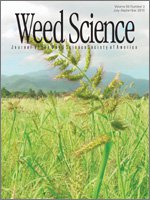Sheep sorrel is an invasive, creeping perennial weed of lowbush blueberry fields. It is one of the most prominent weeds in blueberry fields in Nova Scotia and is responsible for decreasing yields. Three levels of fertilizer (0, 20, 40 kg N ha−1) and two levels of hexazinone (0 or 1.92 kg ai ha−1) were applied to experimental plots to determine their effects on sheep sorrel density. Sprout-year hexazinone reduced sheep sorrel densities, which led to increased yields. Fertilizer increased weed density in the absence of herbicides, had no effect on density in the presence of herbicides, tended to have no impact on floral buds, and did not increase yields. Fruiting-year hexazinone decreased sheep sorrel densities in some situations, but did not result in yield increases.
Nomenclature: Hexazinone, Velpar; sheep sorrel, Rumex acetosella L.; lowbush blueberry, Vaccinium angustifolium Ait. and Vaccinium myrtilloides Michx.





